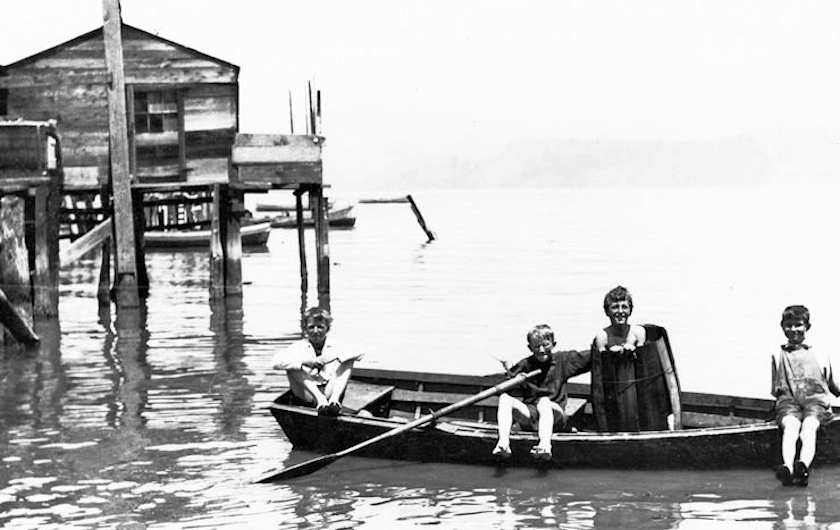
We’ve written previously about Donlon Arques, the legendary Godfather of the Waterfront in postwar Sausalito. Now, thanks to research from Knapp & VerPlanck Preservation Architects and the Sausalito Historical Society, we know that the Arques family has roots as deep as the eel grass in Richardson’s Bay.
Don’s father Camilo Luis Arques was a boatbuilder, and his mother, Teresa Arques (nee Clyne) was a California native of Irish parentage. Don’s grandfather Luis was born in Monterey and his great grandfather Jose was born in Barcelona.
Camilo Arques started his Sausalito yard at the foot of Napa Street in 1913. The business conducted commercial pile driving, hauling, and dredging. Camilo had sternwheel towboats that carted supplies up and down the Sacramento River. Two of them are now under the mud at Galilee Harbor. An article in the Sausalito News from 1914 announced the yard’s launch of the cabin steamer Grace Barton, “a sight–seeing steamer with a carrying capacity of three hundred.” The Grace Barton was sold to D. W. Griffith (one of the most influential figures in the history of motion pictures) who made a movie right off Napa Street, and then blew the Grace Barton up.
Camilo had five barges which he used to deliver molasses to the American Distilling facility located at what is known today as Whiskey Springs. He also transported lumber that was shipped down in lumber schooners from Aberdeen, Seattle, Olympia, or Tacoma in Washington. They would load the lumber on the barges alongside each schooner, and then take the lumber into Sausalito.
In 1915 Camilo moved his boatyard to Johnson Street in deeper water so he could bring larger boats in. A customer who wound up not being able to pay for barges built by Camilo gave him eight underwater blocks in north Sausalito, now known as Waldo Point. When barges were left on the ways or boat ramps at the Johnson Street yard, Camilo would tow them up to Waldo Point and beach them on the mud. When the tide ran out, the water ran out of the holes on a barge, and Camilo would use a “softpatch” to float the barge and then tow it back up to the ways at Johnson Street.
Don Arques was raised around boats and boat building. He later recalled, “I was brought up as a kid on boats. I was broken–in like that.” Thanks to his generosity, Waldo Point became the epicenter of the houseboat community, when WWII veterans going to school on the G.I. Bill were allowed to commandeer surplus barges and boat hulls from Marinship and convert them to living quarters on his property.
Don Arques died in 1993, after he and his wife Verna put their property at Gate 3 into a charitable educational trust and a maritime preservation foundation. That legacy has evolved into The Arques School of Wooden Boatbuilding at Spaulding Marine Center, 600 Gate 5 Rd. The small school is dedicated to teaching the art of traditional wooden boatbuilding. Today it’s staffed by Bob Darr, who founded it in 1996, and historian Raymond Cage who worked at the Arques shipyard with his father Lindsay in the ’60s.
The Historical Society has recently opened a new exhibit on the third floor of City Hall featuring photos, tools, and memorabilia collected over the years from the Arques boatyard. The exhibit includes items from the Historical Society’s archives as well as from the Arques Preservation Foundation and the San Francisco Maritime Museum. It’s free and open to the public 10:00 a.m. to 1:00 p.m. on Mondays and Wednesdays, and 12:00 to 3:00 p.m. on the second and fourth Saturdays of each month.